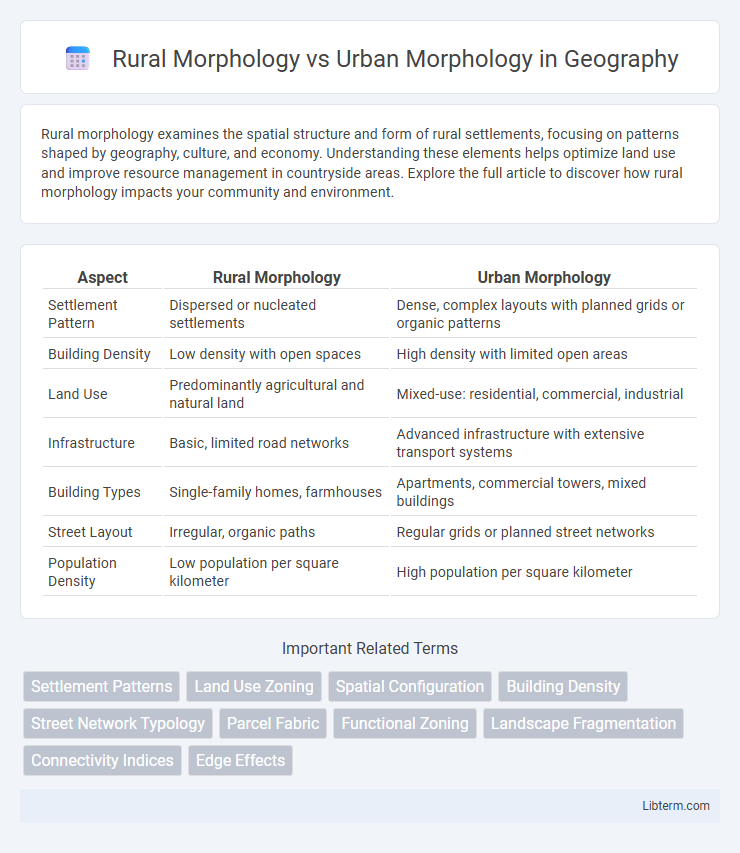Rural morphology examines the spatial structure and form of rural settlements, focusing on patterns shaped by geography, culture, and economy. Understanding these elements helps optimize land use and improve resource management in countryside areas. Explore the full article to discover how rural morphology impacts your community and environment.
Table of Comparison
| Aspect | Rural Morphology | Urban Morphology |
|---|---|---|
| Settlement Pattern | Dispersed or nucleated settlements | Dense, complex layouts with planned grids or organic patterns |
| Building Density | Low density with open spaces | High density with limited open areas |
| Land Use | Predominantly agricultural and natural land | Mixed-use: residential, commercial, industrial |
| Infrastructure | Basic, limited road networks | Advanced infrastructure with extensive transport systems |
| Building Types | Single-family homes, farmhouses | Apartments, commercial towers, mixed buildings |
| Street Layout | Irregular, organic paths | Regular grids or planned street networks |
| Population Density | Low population per square kilometer | High population per square kilometer |
Introduction to Settlement Morphology
Settlement morphology studies the form and structure of human settlements, distinguishing between rural and urban morphology based on density, layout, and land use patterns. Rural morphology typically features dispersed settlements with organic growth patterns influenced by agricultural activities, while urban morphology involves compact layouts, planned street grids, and mixed land uses reflecting complex social, economic, and infrastructural functions. Understanding these morphological differences helps in analyzing spatial organization, historical development, and functional dynamics of settlements.
Defining Rural Morphology
Rural morphology refers to the study and analysis of the physical layout, structure, and organization of rural spaces, including land use patterns, settlement types, and natural features. It emphasizes dispersed settlements, agricultural land uses, and low population density, contrasting with the dense, built environments typical of urban morphology. Understanding rural morphology involves examining spatial relationships among fields, farms, villages, and natural landscapes to inform sustainable rural planning and development.
Defining Urban Morphology
Urban morphology examines the physical form and structure of cities, analyzing patterns of streets, buildings, and open spaces to understand urban growth and development. It involves studying the layout, design, and organization of urban areas, including the arrangement of blocks, plot sizes, and land use distribution. This field contrasts with rural morphology, which focuses on the spatial patterns and structures of countryside environments characterized by dispersed settlements and agricultural land.
Historical Evolution of Rural and Urban Forms
The historical evolution of rural morphology is characterized by dispersed settlements, agricultural land use, and organic growth patterns shaped by local environmental conditions and traditional farming practices. Urban morphology evolved through planned layouts, density-driven development, and infrastructural advancements reflecting industrialization and socio-economic transformations. Both morphologies reveal distinct spatial organizations that illustrate the shift from agrarian-based communities to complex urban systems.
Structural Patterns in Rural Settlements
Structural patterns in rural settlements exhibit dispersed or nucleated forms influenced by agricultural practices, topography, and resource availability. Unlike the dense and grid-like patterns of urban morphology, rural morphology features irregular layouts with organic road networks and homesteads scattered according to land use needs. These spatial arrangements optimize access to arable land and water sources, reflecting functional adaptations to local environmental and economic conditions.
Structural Patterns in Urban Settlements
Urban morphology studies the structural patterns of cities, characterized by high-density layouts, grid-like street networks, and mixed land uses that support complex social and economic interactions. In contrast, rural morphology typically features dispersed settlements, organic road patterns, and predominantly agricultural land use, reflecting lower population density and simpler infrastructural systems. These differences in spatial structure influence urban planning, transportation efficiency, and community connectivity within diverse settlement contexts.
Functional Differences: Rural vs Urban Space Use
Rural morphology primarily emphasizes agricultural land use, low-density settlements, and natural resource management, reflecting a dispersed spatial pattern designed for farming and open space. Urban morphology features high-density development, mixed land uses, and infrastructure concentrated around commercial, residential, and industrial functions that support complex social and economic interactions. Functional differences arise as rural spaces prioritize production and natural resource utilization, while urban areas focus on services, connectivity, and diverse economic activities.
Influencing Factors in Rural and Urban Morphology
Rural morphology is primarily influenced by natural factors such as topography, soil fertility, and climate, which shape settlement patterns, land use, and building forms. Urban morphology, on the other hand, is driven by socio-economic factors including population density, infrastructure development, zoning laws, and historical growth patterns. Both rural and urban morphologies are also affected by cultural practices and technological advances, but urban areas show greater complexity due to diverse functional needs and economic activities.
Challenges in Analyzing Morphological Differences
Analyzing morphological differences between rural and urban areas presents challenges such as variability in spatial patterns, where rural morphology often features dispersed settlements and irregular land use, while urban morphology exhibits dense, planned layouts with complex networks. Data scarcity and inconsistent measurement methodologies complicate comparative studies, as rural areas lack detailed mapping and standardized metrics available in urban settings. These difficulties hinder accurate modeling of growth trends and the formulation of effective planning policies tailored to distinct morphological characteristics.
Implications for Sustainable Planning and Development
Rural morphology, characterized by dispersed settlements and agricultural land use, contrasts with urban morphology's dense, mixed-use patterns, significantly influencing sustainable planning strategies. Understanding these spatial structures aids in optimizing resource allocation, preserving natural landscapes, and enhancing connectivity in both contexts. Integrating rural and urban morphological principles supports resilient infrastructure development and mitigates environmental impacts through tailored land-use planning.
Rural Morphology Infographic

 libterm.com
libterm.com